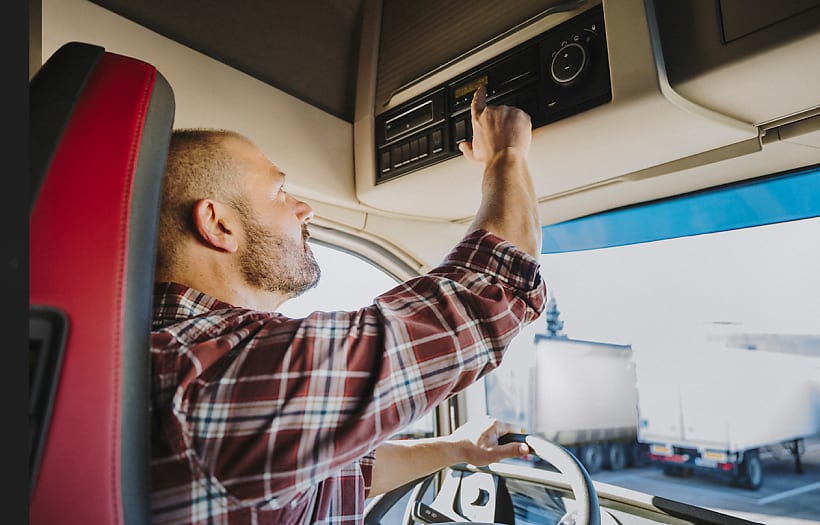When it comes to tachograph compliance, fleet managers as well as drivers hold responsibility. But what about double manning and working with a digital tachograph—how do the tachograph rules apply? This article will help you understand the legal requirements as they apply to the UK and within the EU.
It’s not easy to remember all the rules—or even to visualise how they work. So, we’ve created an example double manning schedule for working with a digital tachograph to help you see how it could work in practice for your fleet.
When can a vehicle be considered double manned?
As the word “double” implies, a vehicle is considered double manned when two professional drivers are present in the cab. But there’s more to it than that. Both drivers must:
- Insert their tachograph Driver Card in the relevant slot
- Be ready and legally eligible to take on driving duty
- Stick to rules on working times, breaks and rest periods
- Remain in attendance for the entire day’s driving duty (exception: during the first hour, the first driver can be the only driver on duty, such as required to prepare the vehicle or drive to a location to pick up the second driver. The second driver must be on duty within the hour.)
How to use a tachograph when double manning
Setting up your tachograph for double manning is straightforward. Here are step-by-step instructions:
- The cards must be inserted in their appropriate slot as soon as possible—your best bet is for each driver to do this immediately after entering the cab, before going out on the road. Remember: both drivers must be in the vehicle within the first hour of duty.
- The person who is sitting behind the wheel for a shift inserts their card into slot 1, which is the driver’s slot. The person who is sitting in the passenger’s seat places their card into slot 2.
- When swapping seats, the drivers must switch the slot placements of their Driver Card. Once a driver moves from behind the wheel to the passenger seat, their Driver Card must be taken out of slot 1 and inserted into slot 2. The first 45 minutes of their time in the passenger seat counts as a break.
What are the driving hours for double manning?
For double manning to work effectively, both drivers must be ready and legally eligible to take on driving duty. So, they must adhere to drivers’ hours rules. Here are the most essential rules when it comes to double manning:
- Do your drivers need to travel to a vehicle location that isn’t your business? Then any commuting time spent getting to a vehicle that isn’t parked at your operations is categorised as “other work”.
- Breaks do not count towards the minimum daily resting period of 9 hours during any 30-hour timeframe that starts upon completing the last daily or weekly rest period. The required break times and resting periods apply to both drivers.
Need more clarity on driving hours, breaks, rest periods and working times? See our simple breakdown of drivers’ hours regulations.
Advantages and challenges of double manning

Any fleet manager or professional driver reading this probably wonders whether double manning can help maximise productivity. The short answer is yes.
The daily driving limit for a single driver is 9 hours, which can go up to 10 hours twice per week. By double manning, you essentially double the amount of driving time you can do—as long as regulatory conditions like those mentioned in the section above are met. That’s a clear advantage. Let’s look at a few others, followed by some challenges to keep in mind.
Advantages of double manning
- Faster delivery schedules: Since double manning enables your driving duo to stay on the road longer, you may be able to halve your customer delivery time.
- Improved road safety: Alternating time behind the wheel helps drivers reduce fatigue, the primary issue behind most road accidents.
- Increase cost savings: Serving customers quicker while preventing safety issues can add up to more jobs done and less budget spent on insurance premiums.
Challenges of multiple drivers
- People management: You’ll want to have processes in place for resolving driver disputes should they pop up. And what if one of the drivers calls in sick—do you then need to rework your delivery schedule, or can you easily call in a substitute driver?
- Performance monitoring: You and your drivers may need to rethink how you analyse performance. Do you look at the totality of a trip and count the two drivers as a single team, for example?
- Compliance logistics: When the non-driving half of the team is in the passenger seat, they’re not permitted to perform any kind of work, no matter how simple a task may be. For the sake of compliance, your back-office team needs to know which driver it can communicate with at certain times.
Double manning schedule example

| Driver activities | Timeframe |
|---|---|
| Driver 1 arrives to a non-company parking lot to pick up the vehicle. They do a walkaround, ensuring the vehicle is roadworthy. They then drive to the company to pick up Driver 2. Both drivers have inserted their Driver Card into the appropriate slots. | First hour of the driving day |
| Driver 1 performs the first shift at the wheel. No work is performed by Driver 2. | 4.5 hours |
| The drivers switch roles, remembering to switch their Driver Card placements in the tachograph. So, the Driver Card for Driver 1 is now inserted into slot 2, which is set as a period of availability, or POA. The first 45 minutes of this POA is categorised as a break. Driver 2 takes on driving duties. | 4.5 hours |
| Driver 1 performs a second shift at the wheel. No work is performed by Driver 2, who may take the first 45 minutes of POA as a break. | 4.5 hours |
| Driver 2 performs a second shift at the wheel. No work is performed by Driver 1, who may take the first 45 minutes of POA as a break. | 4.5 hours |
| In both the UK and the EU, the daily limit can be increased for each driver to 10 hours per day, twice per week. If this threshold hasn’t been reached yet, the drivers may swap roles for one more hour of driving each, totalling two hours of additional driving altogether. | 1 hour + 1 hour |
| Since both drivers have driven the maximum time allowed, they must now rest. This example schedule is based on 10 hours of driving time for each driver, so the rest period is reduced by one hour. | 9 hours |
Have questions about tachograph rules and double manning?
Benefiting from double manning requires some careful planning. With the right system in place, you can maximise productivity while enhancing road safety and customer satisfaction.
If you could use some personalised advice on getting more out of your time on the road, we can help. Book a call with one of our fleet experts, who can answer your questions and show you how to boost efficiency and improve overall fleet performance.
LEVERAGE YOUR COMPLIANCE
Make the most of smart tachograph rules with our free guide.








